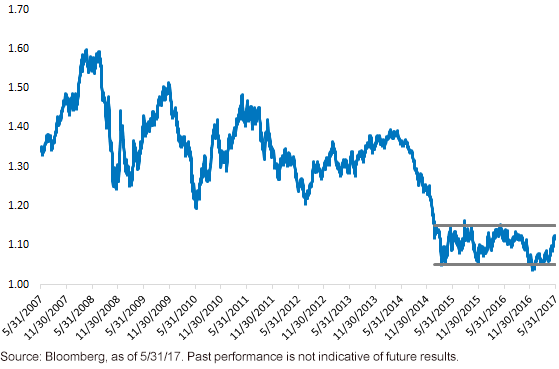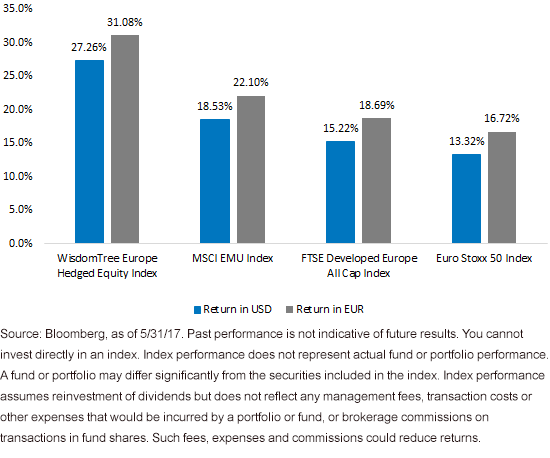Does It Really Matter Where The Euro Goes?
Nowadays, everyone has an opinion. Especially when it comes to the euro.
Going into 2017, market consensus was that the U.S. dollar would strengthen over the course of the year, and the euro stood at 1.04 per U.S. dollar. Bearish euro positioning has largely unwound since then and the currency has rallied, standing at 1.12 at the end of May.
Value investors contend that even after the rally, the euro is still undervalued compared to the dollar. Technical signals show that the euro has reached “overbought” levels and is primed to fall. Momentum indicators hint that the euro should continue to rise. Interest rate differentials still suggest that the euro should fall. And at the end of May, net speculative positioning in the euro reached its most bullish level since 20111—and no doubt, both euro bulls and bears would view this last data point as evidence in their favor.
Where Will the Euro Go Next?
In short, currencies are notoriously difficult to predict. WisdomTree has worked with Record Currency Management to develop a rules-based approach that aims to add value over the long run using three currency indicators—and even these indicators are showing conflicting signals. The point of this blog post is not to provide an outlook on the euro.
The point is, for investors buying European equities right now, does it matter where the euro goes?
Case for Europe Equities Strengthening
Before talking about the currency, we should discuss European stocks themselves. To be sure, the fundamental case and outlook for European equities has improved significantly in recent months:
- Corporate earnings revisions have soared2
- Economic surprises have been positive.3
- Valuations compared to U.S. equities are attractive.
- Elections have been won by market-friendly candidates.
- Continued easy monetary policy has come from the European Central Bank (ECB).
As a result of these positive developments, flows have returned in a big way, with $10.5 billion in flows into broad-based European ETFs since the end of February4—a sharp contrast to the $23 billion in outflows in 2016. Clearly, investors are paying attention to Europe once again.
Euro’s Moves Have Been Relatively Tame
Back to the euro. After significantly weakening during the ECB QE program, the euro has almost exclusively been range bound between 1.05 and 1.15 since January 2015. There have been intermittent periods of strength and weakness, but in total, the currency has not moved in a significant way over the last two-plus years.
Price of 1 Euro in U.S. Dollars

Conversations about the euro inevitably prompt questions from investors about whether they should hedge their investments there. Our research has shown that over the long run, hedging euro exposure has reduced volatility and enhanced returns.5 But because many investors don’t hold positions for 20 years, and since the euro is experiencing arguably its longest period of relative stability, the last few years provide an interesting case study.
With the euro not having shown sustained strength or weakness since January 21, 2015 (the day the euro first crossed below 1.15), would investors have been better off being hedged or unhedged?
To be blunt, it did not matter.
Index Returns from 1/21/2015–5/31/2017

Regardless of whether performance was measured in dollars or euros, the WisdomTree Europe Hedged Equity Index handily outperformed some of the most commonly followed cap-weighted European equity indexes. That the hedged WisdomTree Index could do so in a nondirectional currency environment implies that it was more than just the currency aspect that drove returns. Why?
Don’t Miss the Forest for the Trees: Stocks!
WisdomTree launched its first ETFs in 2006, based on the idea that there was a better way to invest than in cap-weighted strategies. To point, several factors differentiate the WisdomTree Europe Hedged Equity Index from its comparable cap-weighted equity indexes:
- Dividend-Paying Stocks: Companies must pay at least $5 million in annual cash dividends to be included in the Index, which places a focus on companies that regularly reward shareholders via dividends.
- Exporters: Companies must derive at least 50% of their revenues from outside Europe, giving the Index a global reach.
- Dividend Weighted: WisdomTree’s Dividend Stream® process magnifies the impact of the largest dividend-paying stocks on the overall Index.
- Annual Rebalance: Every year, the WisdomTree Index will rebalance back toward the relative value of dividends, which acts as a disciplined value mechanism that typically results in selling the previous year’s winners and buying the losers.
Sometimes conversations about international investing can be overshadowed by the impact of currencies. Perhaps the question investors should be asking right now is not “Where will the euro go?” or “Should I be hedged or unhedged?” Instead, perhaps the question should be “If I’m investing in Europe, what stocks do I want to own?”
Investors looking toward European equities can invest in the ETF that tracks the WisdomTree Europe Hedged Equity Index, the WisdomTree Europe Hedged Equity Fund (HEDJ).
1Source: Bloomberg, 6/5/17.
2Source: Merrill Lynch, 6/6/17.
3Source: Bloomberg, as of 5/31/17.
4Source: Bloomberg, as of 6/8/17.
5Sources: Bloomberg, MSCI. From 4/30/1998 to 3/31/2017.
Disclosure: Neither WisdomTree Investments, Inc., nor its affiliates, nor Foreside Fund Services, LLC, or its affiliates provide tax advice. All references to tax matters or information provided ...
more


